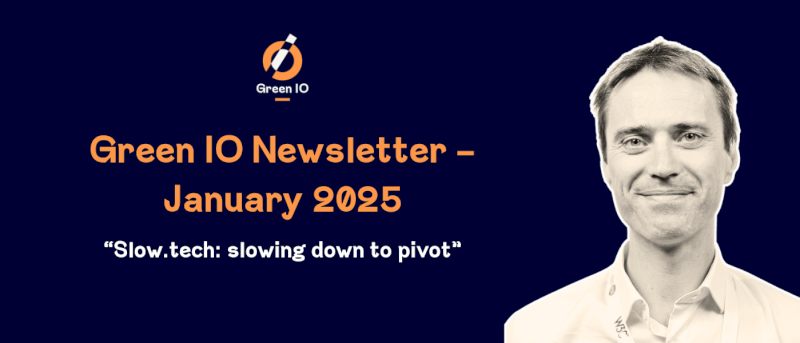Articles
Slow.tech: slowing down to pivot

Hello responsible technologist!
This newsletter comes a bit late for a good reason which is the release of the much awaited update of the 2019 GreenIT.fr study on the global environmental footprint of IT (see below). A study in which Frédéric Bordage, our guest this month, played a significant part. Frédéric is widely acknowledged as one of the spearheads of Green IT in France and beyond for the last … 20 years! He was actually the founder of the GreenIT.fr initiative back in 2024. Today he advocates for a more radical approach than just greening high-tech: embracing Slow.tech.
“Slow.tech: slowing down to pivot” by Frédéric Bordage
One of my favorite tasks within Green IT (FR) and Resilio is preparing for the future and inventing the methodologies you will apply in your organization in a few years. This is how we brought to life and grew methodologies such as digital sobriety, sustainable digital best practices, and digital service eco-design.
For the past 10 years, I have been working on a new methodology to extend digital sobriety to technology in general and to push eco-design a step further. I called it slow.tech (FR), and after many discussions with Léa Bitard (EPFL / Resilio), we published a manifesto for a slower tech.
Slow.tech is essential
Slow.tech is essential. For the environment, for human health, and for society.
There is no more room for the Promethean full high-tech future that tech giants promise to us. This future will not happen. Mainly because of the lack of natural resources. At the rate we are consuming abiotic resources to manufacture high-tech products, even without considering the environmental costs this entails, we only have a few decades of high-tech left. For example, according to my calculations, we have only 2 years of buffer stock for Ruthenium (Ru), 10 years for Antimony (Sb), 11 years for Tin (Sn), and 22 years for Silver (Ag). A slight increase in the consumption of these resources in the coming years will lead to shortages and, therefore, the inability to produce all the high-tech we want. And don’t dream! Mining asteroids is pure science fiction; and collecting polymetallic nodules deep in the oceans would be an ecological nightmare.
Shrinking our technological footprint by a factor 10
In Western countries, our individual high-tech usage exceeds several times our yearly sustainable budget (planetary boundaries divided by the number of Earth inhabitants). Digital technology alone accounts for 40% of our yearly sustainable budget. And when one adds all our high-tech usage, one already needs several individual sustainable yearly budgets. In other words, in Western countries, we must cut our high-tech usage by a factor of 10 for our lifestyle to be sustainable.
And that's without taking into account all the health, social and societal dimensions: screen addiction, personal data and privacy violation, bias in AI’s models, ...
Finally, from a societal perspective, human society’s dependence on high tech is such that any disruption in its availability, even for a few years, would have considerable repercussions. As a civilization, to be more resilient, we must begin our digital detox, now !
Therefore, we must provide an alternative to a fully high-tech vision of the future (which will not materialize) and create a technology that is useful, respectful of human beings, and even desirable, rather thana technology that manipulates, exploits, and enslaves.
Definition of slow.tech
Like digital sobriety, slow.tech is multifaceted. It is both:
- A mindset for thinking about our relationship with technology, and;
- An operational méthodology to technical design.
Slow.tech pursues four main objectives:
- Reduce as quickly as possible high-tech contribution to major environmental crises (global warming, biodiversity collapse, etc.);
- Conserve the slice of high-tech really useful for humanity;
Prepare humanity for a civilization that will be less high-tech in a few decades; - Re-establish a calm, serene, and healthy relationship with technology.
Slow.tech in one equation
To summarize this concept and methodology, I often use this formula:
slow . tech = (low + high) . tech
Today, this equation is balanced as follows in Western countries: 10% low + 90% high.
The challenge is to gradually replace high-tech with low-tech. This way, we can slowly move toward a world that will be, whether we like it or not, more low-tech than high-tech.
Within one or two generations, the balance will be reversed, and our equation will inevitably look like this: slow . tech = (80% low + 20% high) . tech. Even in Western countries.
A methodology neither technophobic nor technophilic
This “middle way” is not technophobic. Quite the contrary! It is an approach that aims to conserve as much high-tech as possible, as early as possible. Mostly because the value of high-tech is invaluable for humanity in certain areas.
But, the more time passes, the less this resource will be available. Thus, one should already consider high-tech as a common good. With the progressive depletion of resources, undergoing an MRI for medical treatment or modeling the climate will become increasingly expensive, both ecologically and economically. Slow.tech is therefore a tool in service of humanity.
Slow.tech raises the questions of “how” and “why”. How can we use all available technologies (low and high) most ingeniously? And for what purpose? Artificial intelligence is a good example: it helps detect cancers, but also boosts sales of unnecessary disposable products.
A structured solution to implement sobriety
From an operational point of view, slow.tech answers to the end of “abundance era” with a structured and validated methodology.
For humanity being able to use high technologies as long as possible to meet its critical needs (healthcare, climate modeling, etc.), one must conserve the materials from which we build high-tech. That’s why, when designing a solution with the slow.tech methodology, we systematically try, whenever possible, to replace high-tech with low-tech.
For example, we would replace a 5G mobile app for weather forecasting by a simple SMS. One will keep the supercomputer that predicts the rain, but the 5G app that adds no value can be replaced with a simple text message.
Ultimately, slow.tech is a question of balance between the problem to be solved and the resources used. It is also a different and complementary approach to low-tech, which would probably use a simple barometer and local knowledge to predict rainfall.
Defining scales between low and high-tech
As shown by this example (weather forecasting), when designing a new hybrid system in slow.tech, there are often several graduations between low and high-tech. This scale depends on where one stands: a French executive living in Paris will not describe the scale between high and low tech the same way as a Bangladeshi farmer living in a rural area.
Slow.tech is therefore also a matter of perspective: not everyone starts the process with an equally balanced equation. In the West, we will be at 10% low + 90% high, while in Bangladesh, the orders of magnitude will be reversed. In other words, in slow.tech, the West is far behind compared to “emerging” countries.
An issue for the future, much more important than AI or space tourism
Ultimately, the issue is to design a more sober and peaceful technology for every day life and to pave the way for a future where low-tech will probably be the rule and where the little high-tech that remains should ideally be considered as a common good.
Considering how quickly space tourism and AI are developing, it is uncertain whether humanity has chosen to follow this path. But it seems important to at least outline this way for the future.
Join +2000 responsible readers

Green IO newsletter
Once a month, carefully curated news on digital sustainability and Green IO contents delivered in your mailbox
